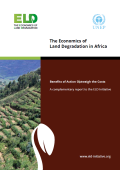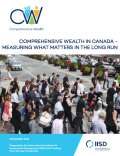
Land degradation and desertification are among of the world’s greatest environmental challenges. It is estimated that desertification affects about 33 % of the global land surface, and that over the past 40 years erosion has removed nearly one-third of the world’s arable land from production. Africa is particularly vulnerable to land degradation and desertification, and it is the most severely affected region. Desertification affects around 45 % of Africa’s land area, with 55 % of this area at high or very high risk of further degradation.

Comprehensive wealth focuses on the role of people, the environment and the economy in creating and sustaining well-being. Complementing indicators like gross domestic product (GDP) and addressing issues the can’t capture on their own, comprehensive wealth measures are key to successfully guiding Canada through the 21st century and beyond.
This study, Comprehensive Wealth in Canada - Measuring what matters in the long run, reviewed Canada’s comprehensive wealth performance over the 33-year period from 1980 to 2013. This timeframe extends well beyond business and political cycles, ensuring that the results reveal trends free from the ebb and flow of markets and policies. The report found that comprehensive wealth grew slowly in Canada between 1980 and 2013 (0.19 per cent annually in real per capita terms). This was in contrast to relatively robust growth in real per capita consumption of goods and services (1.36 per cent annually). The divergence between these two trends points to potential concerns for long-term well-being.
In terms of the components of comprehensive wealth:

This paper identifies opportunities to refine OECD’s indicators of land cover and land use and their regular production for all OECD and G20 countries. A comprehensive review is conducted of the available datasets at the global, regional and national levels, including data derived from remote sensing as well as those complemented with administrative and survey data. The datasets are assessed in terms of their geographic coverage, periodicity, spatial resolution, data reliability and comparability. The paper discusses the potential use of such datasets for the production of indicators that are harmonised across countries and over time. It is found that data on land cover are widely available and that many OECD countries have good-quality national land cover datasets, in some cases consistently over time. However, considerable differences have been found among the land cover products reviewed in terms of their geographic coverage, spatial, temporal and thematic resolution. For eight countries, no country- or region-specific data could be found (including Israel, Korea, Colombia, Costa Rica, India, Indonesia, the Russian Federation and Saudi Arabia).
This Policy Highlights on Green Growth Indicators focuses on measuring progress towards green growth, analysing the sources of green growth and identifying relevant indicators for decision-makers and the wider public is essential for assessing green growth policies. The OECD framework identified 25 to 30 indicators under the four categories: 1) Environmental and resource productivity; 2) The natural asset base; 3) The environmental dimension of quality of life; 4) Economic opportunities and policy responses. Also indicators that describe the socio-economic context and the characteristics of growth are considered in order to complement the main indicators under the four groups.
The economic assessment of low-carbon energy options is the primary step towards the design of policy portfolios to foster the green energy economy. However, today these assessments often fall short of including important determinants of the overall cost-benefit balance of such options by not including indirect costs and benefits, even though these can be game-changing. This is often due to the lack of adequate methodologies.
The purpose of this paper is to provide a comprehensive account of the key methodological challenges to the assessment of the multiple impacts of energy options, and an initial menu of potential solutions to address these challenges.
The paper first provides evidence for the importance of the multiple impacts of energy actions in the assessment of low-carbon options.
The paper identifies a few key challenges to the evaluation of the co-impacts of low-carbon options and demonstrates that these are more complex for co-impacts than for the direct ones. Such challenges include several layers of additionality, high context dependency, and accounting for distributional effects.
